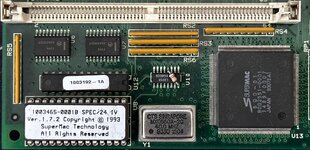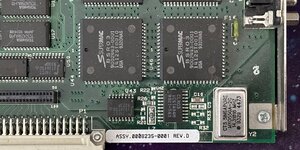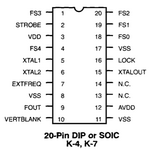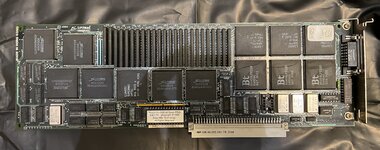@EIMS -- The board you have is basically a Thunder/24 card. It was originally designed/released in late 1991 with spins in 1992 as the next generation after the original Spectrum/24 PDQ as the board that switched to a newer graphics controller (SMT02), bit-shift registers (BSR03) and a custom acceleration ASIC (Squid 01, or SQD01). It was later rebranded as Spectrum/24 IV. Your board is a newer fab rev and slightly different assembly from 1992 (vs. 1991 for the original Thunder fab). For example, I think the original boards used BT DACs. Yours has an Analog Devices DAC and there was no rework on U10.
As in other comments I have posted, SuperMac's initial 24-bit board evolution was: Spectrum/24 (no acceleration) -> Spectrum/24 Series III (PAL/GAL daughterboard accelerator) -> Spectrum/24 PDQ (Xilinx-based accelerator) -> Thunder/24 (custom ASIC accelerator) -- and later re-branded as Spectrum/24 IV (as the distant successor to Spectrum/24 Series III) -- as in the board you have (but it's the same basic design as a Thunder/24).
Over time, there were various ROM upgrades. For example, your v1.7.2 ROM comes from 1993 and probably has some bug fixes, OS compatibility changes, minor improvements and additional video configuration support vs. the original Thunder/24 ROM from 1991 -- v1.15/1.16. There were also later v3.x ROMs from 1994 that included PowerPC support and additional SuperVideo 3.0 support. The ROMs were usually branded with whatever the original board marketing designation happened to be (to maintain the customer perception of a totally unique design) -- like Thunder/24 v3.0.
In some cases, there is not much substantive difference in the boards. For example, the original PDQ+ board is just a ROM-gimped version of Thunder/24 without the GWorld RAM slots. Importantly, PDQ+ boards will work with faster Thunder/24 ROMs that have full graphics acceleration performance. So, if you have a PDQ+, put a Thunder/24 ROM in it and hotrod that puppy. It was just marketing smoke and mirrors. Wait...I mean "strategy."

The PDQ+ board looked different enough without the RAM slots/connectors that it was just a Thunder/24 hiding in plain sight.
SuperMac wanted to have a price and performance marketing spread across the 24-bit high-end video market -- for example:
"SLOWER/CHEAPER"
Spectrum/24 Series III -- 1989 -- no accelerator board (to replace Spectrum/24) (Codename: Easy)
Spectrum/24 Series III -- 1989 -- with accelerator (Codename: Easy Rider, "Rider" was the daughterboard)
Spectrum/24 PDQ -- 1990 -- (Codename: Shockwave)
Spectrum/24 PDQ+ -- 1991 -- (Codename: Poptart, a ROM gimped version of Thunder/24 without GWorld RAM or DSP board connectors)
Thunder/24 -- 1991 -- (Codename: Pop, full performance with GWorld acceleration RAM slots and DSP board connectors)
Spectrum/24 IV (aka Thunder/24)
Spectrum/24 V (but the same basic architecture)
etc.
"FASTER/MORE EXPENSIVE"
(For a short time, before EoL of the older products, all of the above boards were available in the market concurrently, with older boards dropping in price over time.) ...and later, SuperMac rolled in the Storm board as a plug-in DSP-based accelerator -- then on to GX, etc.
These SKUs made it hard for others to compete at any given price/performance point and ensured that SuperMac would win every benchmark or value comparison.
There was a breakfast theme for the Thunder-era board codenames. For example, Pop was Pop because of:
Snap: Spectrum 8•24 PDQ (an accelerated upgrade for the Spectrum/8 Series III board that also had 24-bit support on smaller monitors and 8-bit support on larger monitors, like 21" 1152x870)
Crackle: Thunder/8 (an 8-bit card that offered GWorld support and optional DSP daughtercard accelerator)
Pop: Thunder/24 -- the full package
...and then
PopTart, the Spectrum/24 PDQ+ as a gimped Thunder/24 without GWorld slots. And "PopTart," because SuperMac needed another codename that was related to Pop and also a tasty breakfast item.
The SuperMac 8-bit board space had similar evolution over time:
Original Spectrum/8 -- 1987 -- SuperMac's first 8-bit color video card. It had a genlock sync input and worked with Julian Systems equipment, etc. The early versions of SuperVideo also had a chromakey slurping tool that would let you choose a drop-out (ie. green screen) color. TI graphics controller. I think it used to make a slurping sound when you used it to pick up a color from the background.
Spectrum/8 Series II, or "Spectrum C" -- 1988 -- a revised version of the original Spectrum/8 board with fixes, TI graphics controller. These boards are easy to spot because the ROMs say "SPEC C" on them.
Spectrum/8 Series III (Codename: George) -- 1989 -- the first 8-bit board to use an SMT01 controller. This board had a long life and was an unaccelerated, eventually "low-end" bread-and-butter 8-bit solution for SuperMac.
Spectrum 8•24 PDQ (Codename: Snap) -- 1991 as above
Thunder/8 (Codename: Crackle) -- as above
(...and as the codenames imply, the Snap/Crackle/Pop/PopTart boards were developed in the same timeframe in 1991 - busy, busy, busy)
And, of course, there were boards for smaller screen configs, custom machines/PDS, monochrome, etc., but that is a tale for another day, Bilbo.









